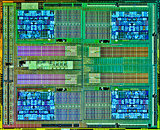Tuesday, December 30th 2014

AMD to Switch to GlobalFoundries' 28 nm SHP Node in 2015
Faced with continuous development roadblocks with TSMC, AMD is reportedly planning to switch to the 28 nm SHP process of GlobalFoundries, to build GPUs in 2015. The 28 nm SHP (super high-performance) node will allow the company to lower voltages, giving it greater room to increase clock speeds of its upcoming GPUs. AMD's GPUs in 2015 could be based on its latest Graphics CoreNext 1.2 architecture, and AMD needs every means to minimize voltages, and crank up clock speeds.
The company hasn't abandoned TSMC completely just yet, with reports speaking of AMD using the Taiwanese fab's 16 nm FinFet node to manufacture its next-generation "Zen" CPUs. Zen is the successor to AMD's "Bulldozer" architecture and its derivatives ("Piledriver" and "Steamroller.") It could feature a radically different core design.
Source:
BitsandChips.it
The company hasn't abandoned TSMC completely just yet, with reports speaking of AMD using the Taiwanese fab's 16 nm FinFet node to manufacture its next-generation "Zen" CPUs. Zen is the successor to AMD's "Bulldozer" architecture and its derivatives ("Piledriver" and "Steamroller.") It could feature a radically different core design.

48 Comments on AMD to Switch to GlobalFoundries' 28 nm SHP Node in 2015
I am not a fan of the Zen naming though. IDK why, just am not a fan.
Hats off.
The more time that pass, the deeper my concerens about AMD become.
More surprised though that they are sticking to 28nm SHP over the original shrink that was predicted. I guess the issues could not be worked out so it looks like all graphics cards will be waiting for the skip to the next shrink which is going to be quite a cut in size if I do say so myself.
Zen will be on FinFET most likely at 16/14nm depending on available production in 2016.
As has been discussed here and elsewhere node size does NOT necessarily equal performance potential. As an example GloFo's 28nm SHP allows AMD to significantly lower voltage and power consumption on their graphics cards over TSMC's 28nm process that AMD has used for GPUs.
The general population (aka 99% of the buyers of these products) wont give 2 shits whether its 14 or 22nm in their laptops.
As was said, this was expected to be a split generation complete with hold-overs and replacements across foundries and processes (like how 7970 became 280x, or Tonga on HPM replaced Tahiti using HP). We know another version of Hawaii is coming, and it wouldn't be surprising to see something Tonga-like stick around either. With that said, I can only imagine amd expected more power-savings and/or performance latitude than they got from HPM considering the relative limitations vs HP. GF is probably less-limiting than tsmc HPM...that doesn't necessarily make it better.
From there, it just becomes a question of when is Fiji, and how long between that and (Bermuda?). If the recent past is anything to go by, it could be a bit between each, but I still expect them to release something on a smaller process in 2015 (to compete with GM200). It's important to remember not only is this par for the course (re-using products) but amd has planned to do split-process stacks before. While eventually Cayman was released, for instance, the original plan was for the halo to be on 28nm, with Barts etc on 40nm. Inversely, what became 4770 was supposed to replace 4870 (but 40nm was a mess and we hence got 4890 on 55nm instead). Any of those combinations could occur again.
Things obviously can and do change, and while GF 28nm is a bit more dense (similar to a half-node shrink at the reg 28nm level; SHP may trade some of that size advantage for speed improvements), it has it's own relative issues. I could see voltage going down (if transistors up), but not necessarily clock speeds going up significantly if a similar product, especially at a higher voltage than they currently use. They may gain a die size advantage and more latitude in possible performance, but the power/heat issue will still remain. While recent amd gpus have been limited in clockspeed relative to other chips on the process (I assume because HPM), and GF may better suit a high-logic design, they can't beat physics....just look at their cpus (when approaching a higher-than-ideal clockspeed/voltage). While they could make something more efficiently tuned, to go substantially upwards and onwards I would imagine they need a bigger jump than just switching to 28SHP at GF.
There is really nothing to be concerned about, AMD will be fine.
They still have some nice products (APU's) but they have lost the high end and server market.